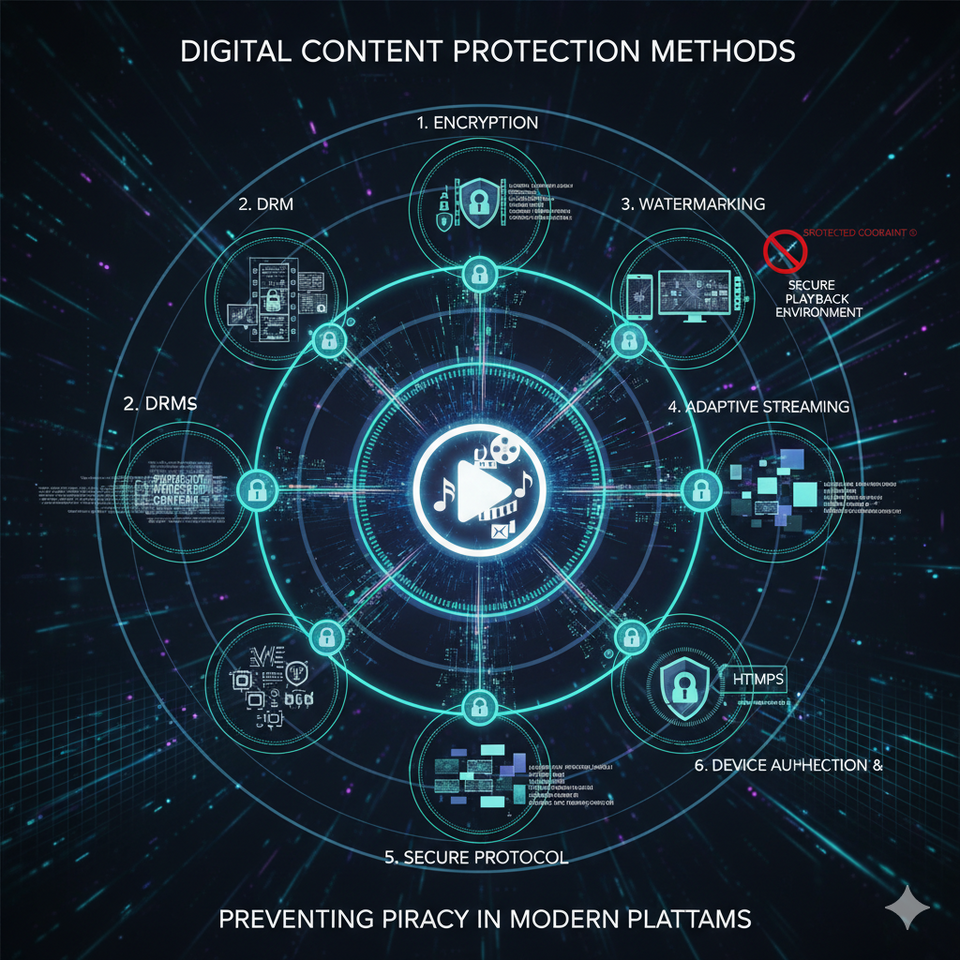Digital Content Protection Methods
What modern digital audio/video transmission and content management systems (like OTT streaming or digital cinema) work together to prevent piracy and protect intellectual property.

How Digital Audio and Video Transmission Helps Prevent Piracy in Modern Content Platforms?
In the age of digital entertainment, movies, music, and shows reach global audiences faster than ever before — through OTT streaming platforms and high-definition digital cinema systems. While this revolution has made content more accessible, it has also opened new doors for piracy, one of the most persistent threats to the media and entertainment industry.
Piracy not only devalues creative work but also drains billions of dollars in potential revenue every year. According to recent industry reports, the global entertainment sector loses between $40 to $97 billion annually due to illegal content distribution, while India alone faces losses exceeding ₹22,000 crore each year. These staggering numbers have pushed both OTT platforms and cinema chains to adopt advanced digital transmission and encryption technologies to safeguard their intellectual property.
From Digital Rights Management (DRM) systems in OTT streaming to encrypted Digital Cinema Packages (DCPs) with Key Delivery Messages (KDMs) in theaters, and HDCP-protected HDMI/HDBaseT links that prevent unauthorized signal capture — every stage of digital audio and video delivery is now tightly controlled and monitored. Add to this audio watermarking and forensic fingerprinting, and content owners can not only prevent leaks but even trace the source if piracy occurs.
In this article, we’ll explore how these digital transmission standards and security protocols work together to ensure that every pixel and soundwave you experience on screen remains both authentic and protected — from studio to viewer.
1. End-to-End Content Protection in OTT and Digital Cinema
Both OTT (Over-The-Top) platforms and digital theaters rely on a secured delivery chain from the content owner to the playback device.
DRM (Digital Rights Management)
-
Core Layer of OTT protection
-
Platforms like Netflix, Prime, Disney+, etc., use multi-DRM systems (Widevine, PlayReady, Fair Play).
-
Each video file is encrypted (AES-128/CTR or AES-128/CBC).
-
Only licensed players with secure keys can decrypt it.
-
Playback keys are time-bound and device-bound, meaning:
-
You can’t copy the file and play it elsewhere.
-
Downloaded offline content expires after a license duration.
-
-
DCP and KDM in Theaters
-
Digital Cinema Packages (DCP) contain encrypted video/audio files.
-
KDM (Key Delivery Message) provides the decryption key:
-
Unique to each projector/server serial number.
-
Valid only for a specific time window (e.g., show dates).
-
Prevents copying or unauthorized playback in another theater.
-
2. Secure Digital Transmission (HDMI, HDBaseT, SDVoE, etc.)
Once decrypted inside the playback device, signals still must be protected during transmission to displays or projectors.
HDMI (High-bandwidth Digital Content Protection)
-
HDCP (High-bandwidth Digital Content Protection) — an encryption protocol within HDMI.
-
Prevents capturing unencrypted signals between devices.
-
Every HDMI chain performs a “handshake”:
-
Source verifies that the sink (display/projector) is HDCP-compliant.
-
If not, transmission is blocked or downscaled to low resolution.
-
-
Versions:
-
HDCP 1.x – Basic encryption, 720p/1080p era.
-
HDCP 2.x – Stronger, used for 4K and HDR content.
-
HDCP 2.3 – Current version, integrates with OTT and Blu-ray UHD standards.
-
HDBaseT and AV-over-IP
-
Transports HDMI signals over long distances (CAT6/7 or fiber).
-
HDCP encryption travels inside the HDMI payload, so even over network cable, content remains encrypted.
-
Professional transmitters/receivers are locked to licensed chipsets, making packet sniffing or re-streaming nearly impossible.
3. Audio Watermarking and Fingerprinting
Even audio tracks carry anti-piracy layers.
Audio Watermarking
-
Invisible, inaudible data embedded in soundtrack.
-
Identifies:
-
Origin (OTT, DCP, region, or session ID)
-
User account or device
-
-
Detectable if someone re-records or leaks the content.
-
Used by:
-
Nielsen, Civolution, and Kantar for tracking.
-
Studios for anti-Cam cording detection in cinemas.
-
Audio/Video Fingerprinting
-
Uses AI pattern recognition to identify leaked copies.
-
Helps remove pirated copies quickly from online platforms (YouTube, torrents, etc.)
4. Controlled Streaming Protocols and CDN Security
OTT platforms distribute encrypted streams via HTTPS + Token Authentication.
-
Geo-locking – restricts access to licensed regions.
-
Session-based tokens – prevent URL sharing.
-
Adaptive Bitrate Streaming (ABR) – delivers chunks (HLS/DASH), each encrypted separately; prevents continuous stream ripping.
-
CDN edge nodes only serve content to verified sessions.
5. Secure Hardware and Trusted Execution Environment (TEE)
Playback devices (Smart TVs, Firesticks, projectors) contain:
-
Hardware DRM modules (e.g., Google Widevine L1, Apple Fair Play).
-
TEE (Trusted Execution Environment) where decryption and frame rendering happen securely, so video data never leaves as clear, recordable frames.
Example – In a Commercial AV Setup
| Component | Security Layer |
|---|---|
| Blu-ray Player | HDCP encryption enabled |
| HDMI to HDBaseT Transmitter | Encrypted signal pass-through |
| HDBaseT Receiver | HDCP-compliant device, authenticated |
| Display/Projector | HDCP key verified — only authorized playback |
If a recording device or non-HDCP capture card is inserted anywhere in between → the content will black out or show a “HDCP Unauthorized Device” error.
🚫 Prevents These Piracy Methods
-
❌ Unauthorized HDMI recorders or capture cards
-
❌ Intercepting raw video signal through splitters
-
❌ Cloning content over IP or wireless transmitters
-
❌ Reusing decryption keys after revocation
Summary Table
| Layer | Technology | Piracy Prevention Function |
|---|---|---|
| Content Encoding | AES Encryption, DRM | Prevent unauthorized playback or copying |
| Cinema Distribution | DCP + KDM | Playback control tied to hardware/time |
| Transmission | HDCP (HDMI/HDBaseT) | Block unauthorized devices from capturing video |
| Audio Protection | Watermarking | Identify leaks, trace origin |
| Delivery Network | HTTPS + Tokens | Stop downloaders, enforce geo/user locks |
| Playback Device | Secure TEE, Hardware DRM | Stop screen recording or memory dumps |
In Simple Terms
Every stage — from studio to screen — has encryption, authentication, and identity verification.
That’s why even if someone physically taps into a professional AV link or OTT stream, they can’t get a usable copy of the content.
-
Xchange Advocates are recognized AV/IT industry thought leaders and influencers. We invite you to connect with them and follow their activity across the community as they offer valuable insights and expertise while advocating for and building awareness of the AV industry.
Recommended Content
Immersive Experiences, Sustainability in AV, AI in AV, Broadcast AV, Command and Control, Digital Signage, Live Events / Performance Entertainment, Business of AV, A Culture of Inclusion, Celebration of AV Excellence, InfoComm, Sustainable AV , AV/IT Buyers, AV Education for The Next Generation, Xchange Advocate Room
AV for Sports Industry in India with Cricket Prospective






Please sign in or register for FREE
If you are a registered user on AVIXA Xchange, please sign in